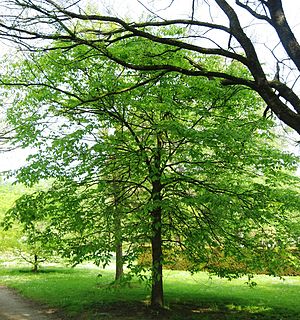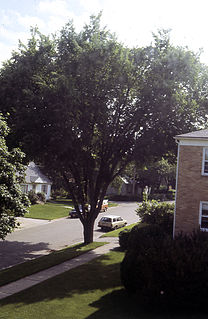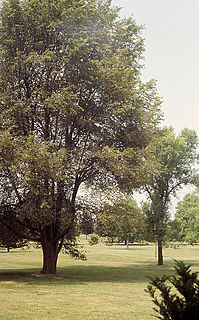Related Research Articles

Ulmus rubra, the slippery elm, is a species of elm native to eastern North America. Other common names include red elm, gray elm, soft elm, moose elm, and Indian elm.

Ulmus thomasii, the rock elm or cork elm, is a deciduous tree native primarily to the Midwestern United States. The tree ranges from southern Ontario and Quebec, south to Tennessee, west to northeastern Kansas, and north to Minnesota.

The Field Elm cultivar Ulmus minor 'Sarniensis', known variously as Guernsey Elm, Jersey Elm, Wheatley Elm, or Southampton Elm, was first described by MacCulloch in 1815 from trees on Guernsey, and was planted in the Royal Horticultural Society's gardens in the 1820s. It was listed in the Loddiges catalogue of 1836 as Ulmus sarniensis and by Loudon in Hortus lignosus londinensis (1838) as U. campestris var. sarniensis. The origin of the tree remains obscure; Richens believed it "a mutant of a French population of Field elm", noting that "elms of similar leaf-form occur in Cotentin and in northern Brittany. They vary much in habit but some have a tendency to pyramidal growth. Whether the distinctive habit first developed on the mainland or in Guernsey is uncertain."

The hybrid elm cultivar Ulmus × hollandica 'Belgica', one of a number of hybrids arising from the crossing of Wych Elm with a variety of Field Elm, was reputedly raised in the nurseries of the Abbey of the Dunes, Veurne, in 1694. Popular throughout Belgium and the Netherlands in the 19th century both as an ornamental and as a shelter-belt tree, it was the 'Hollandse iep' in these countries, as distinct from the tree known as 'Dutch Elm' in Great Britain and Ireland since the 17th century: Ulmus × hollandica 'Major'. In Francophone Belgium it was known as orme gras de Malines.
The hybrid elm cultivar Ulmus × intermedia 'Coolshade' is an American hybrid cultivar cloned from a crossing of the Slippery, or Red, Elm Ulmus rubra and the Siberian Elm Ulmus pumila at the Sarcoxie Nurseries, Sarcoxie, Missouri, in 1946. At Arnold Arboretum, where there was a specimen, herbarium material was labelled Ulmus pumila 'Coolshade'.
The Siberian elm cultivar Ulmus pumila 'Green King' was once believed to have been derived from a crossing of the Siberian Elm Ulmus pumila with the American Red Elm Ulmus rubra. However, it is now apparent the tree originated as a sport of U. pumila in 1939 at the Neosho Nurseries, Neosho, Missouri.

The hybrid elm cultivar Ulmus 'Den Haag' is a Dutch development derived from a chance crossing of the Siberian Elm cultivar Ulmus pumila 'Pinnato-ramosa' and the Belgian Elm Ulmus × hollandica 'Belgica'. S. G. A. Doorenbos (1891-1980), Director of Public Parks in The Hague, finding that seeds he had sown in 1936 from the Zuiderpark 'Pinnato-ramosa' had hybridized with the local 'Belgica', selected six for trials. The best was cloned and grafted on 'Belgica' rootstock as 'Den Haag'; it was planted first in that city, then released to nurseries elsewhere in the Netherlands. The other five were also planted in The Hague.

The American Elm cultivar Ulmus americana 'Moline' was cloned from a wild seedling transplanted to Moline, Illinois, from nearby Rock River Valley in 1903 and propagated from 1916 by the Klehm Nurseries, Arlington Heights, Illinois.

Ulmus minor 'Rueppellii' is a Field Elm cultivar said to have been introduced to Europe from Tashkent by the Späth nursery, Berlin. Noted in 1881 as a 'new elm', it was listed in Späth Catalogue 73, p. 124, 1888–89, and in subsequent catalogues, as Ulmus campestris Rueppelli, and later by Krüssmann as a cultivar.

The elm cultivar Ulmus 'Koopmannii' was cloned from a specimen raised from seed sent from Margilan, Turkestan by Koopmann to the Botanischer Garten Berlin c. 1880. Noted in 1881 as a 'new elm', it was later listed by the Späth nursery, catalogue no. 62, p. 6. 101, 1885, as Ulmus Koopmannii, and later by Krüssmann in 1962 as a cultivar of U. minor. Margilan is beyond the main range of Ulmus minor. Augustine Henry, who saw the specimens in Berlin and Kew, believed Koopmann's Elm to be a form of Ulmus pumila, a view not shared by Rehder of the Arbold Arboretum. Ascherson & Graebner said the tree produced 'very numerous root shoots', which suggests it may be a cultivar of U. minor. Until DNA analysis can confirm its origin, the cultivar is now treated as Ulmus 'Koopmannii'.
The American Elm cultivar Ulmus americana 'Star' was a selection made by the Plumfield Nursery, Fremont, Nebraska, c. 1945.

The American Elm cultivar Ulmus americana 'Vase' was selected and propagated in the early 20th century by the Klehm Nurseries, Arlington Heights, Illinois, who advertised it at first as Ulmus americana 'Urnii', 'Klehms' American Vase-Shaped Elm', listing it, along with its stablemate Ulmus americana 'Moline', as a "novelty" in 1926, and describing both in some detail. Its original cultivar name, 'Urnii' – doubtful Latin – was changed to 'Vase' by Klehms by the 1930s, the tree also featuring as 'Vase Elm' in the catalogues of the Plumfield Nurseries, Fremont, Nebraska, from 1926, along with Klehms' 'Moline'. Vaughan's of Chicago marketed both from 1927. The Naperville Nurseries of Naperville, Illinois, marketed it from 1929 as 'Klehmii', 'Vase Elm', also introducing Klehms' 'Moline' at the same time.
The elm cultivar Ulmus 'Rubra' was reputedly cloned from a tree found by Vilmorin in a wood near Verrières-le-Buisson in the 1830s. It was listed in the 1869 Catalogue of Simon-Louis, Metz, France, as Ulmus campestris rubra, and by Planchon in de Candolle's Prodromus Systematis Naturalis Regni Vegetabilis (1873) as Ulmus libero-rubra: 'Orme à liber rouge' [:elm with red inner bark]. Elwes and Henry (1913) and Bean (1936) listed it as Ulmus montana [:U. glabraHuds.] var. libro-rubro, the former stating that the tree appeared "identical" to Simon-Louis's Ulmus campestris rubra. A specimen in the Zuiderpark, The Hague, was identified in 1940 as a wych elm cultivar, U. glabraHuds.libero rubro.
The hybrid elm cultivar Ulmus × intermedia 'Rosehill' is an American hybrid cultivar originally raised by the Rose Hill Nurseries of Kansas City, Missouri, as Ulmus 'Rose Hill', without species names, from a selection of Ulmus pumila × Ulmus rubra seedlings made in 1951.
The hybrid elm cultivar Ulmus × intermedia 'Willis' originated as a crossing made by a Mr Minnick of Kansas. Almost certainly derived from a crossing of the Siberian Elm Ulmus pumila and the Red Elm Ulmus rubra, it was originally believed that the male parent was the American Elm Ulmus americana.

The American elm cultivar Ulmus americana 'Pendula' was originally listed by William Aiton in Hort. Kew, 1: 320, 1789, as U. americana var. pendula, cloned in England in 1752 by James Gordon. From the 1880s the Späth nursery of Berlin supplied a cultivar at first listed as Ulmus fulva (Michx.) pendulaHort., which in their 1899 catalogue was queried as a possible variety of U. americana, and which thereafter appeared in their early 20th-century catalogues as U. americana pendula. The Scampston Elm, Ulmus × hollandica 'Scampstoniensis', in cultivation on both sides of the Atlantic in the 19th and 20th centuries, was occasionally referred to as 'American Weeping Elm' or Ulmus americana pendula. This cultivar, however, was distinguished by Späth from his Ulmus americana pendula.

The hybrid cultivar Ulmus 'Androssowii'R. Kam., an elm of Uzbekistan sometimes referred to in old travel books as 'Turkestan Elm' or as 'karagach' [:black tree, = elm], its local name, is probably an artificial hybrid. According to Lozina-Lozinskaia the tree is unknown in the wild in Uzbekistan, and apparently arose from a crossing of U. densa var. bubyrianaLitv., which it resembles, and the Siberian Elm Ulmus pumila.
The American Elm cultivar Ulmus americana 'Sheyenne' was raised by the Plumfield Nursery, Fremont, Nebraska, and introduced to commerce in 1958. 'Sheyenne' is not regarded as a valid cultivar by some authorities.

The hybrid elm cultivar Ulmus × intermedia 'Fremont' is a little-known American hybrid cultivar propagated from a tree found on the Lloyd Moffet property at Fremont, Nebraska. The hybrid is believed to have arisen from a crossing of Ulmus pumila and one of the spring-flowering elms native to North America, probably Ulmus rubra. The source tree was probably an unsold specimen of the Plumfield Nurseries' "Hybrid Elm", a cross between "Chinese elm" and Red elm U. rubra, briefly marketed from 1942 to 1943, but not appearing in later catalogues. This hybrid may have been the same as the cultivar sourced from Plumfield Nurseries at this time as "Hybrid Chinese Elm" and later marketed by the Interstate Nurseries, Hamburg, Iowa, as 'Hamburg'.
Ulmus × intermediaElowsky is a natural hybrid elm occurring across Nebraska and several other Midwestern states, derived from the crossing of Ulmus rubra and Ulmus pumila. As Red Elm U. rubra is far less fertile, and highly susceptible to Dutch elm disease (:DED), it could eventually be hybridized out of existence by U. × intermedia. The hybrid was first reported from the wild in the Chicago region in 1950 and was provisionally named U. × nothaWilhelm & Ware in 1994.
References
- ↑ 'Interstate's New Hamburg Hybrid Elm'; Inter-State Nurseries, Hamburg, Iowa : spring 1950 catalogue; p.34
- 1 2 Green, Peter Shaw (1964). "Registration of cultivar names in Ulmus". Arnoldia. Arnold Arboretum, Harvard University. 24 (6–8): 41–80. Retrieved 16 February 2017.
- ↑ 'Interstate's New Hamburg Hybrid Elm'; Inter-State Nurseries spring 1948 catalogue; p.34
- ↑ 1949 Photograph of young 'Hamburg': 'Interstate's New Hamburg Hybrid Elm'; Inter-State Nurseries, Hamburg, Iowa : spring 1949 catalogue; p.34
- 1 2 Inter-State Nurseries, Hamburg, Iowa : spring 1950 catalogue; p.34
- ↑ Plumfield Nurseries, Fremont, Nebraska, 1942 catalogue, p.20
- 1 2 Plumfield Nurseries, Fremont, Nebraska, 1943 catalogue, p.22
- ↑ L.A. Moffet, manager, Plumfield Nurseries, Fremont, Nebraska: Wholesale trade list for nurserymen, florists and dealers: February 10, 1934; p12
- 1 2 Santamour, Frank S.; Bentz, Susan E. (May 1995). "Updated Checklist of Elm (Ulmus) Cultivars for use in North America". Journal of Arboriculture. 21 (3): 122–131. Retrieved 20 June 2016.
- ↑ Ulmus 'Hamburg' in Handbuch der Ulmengewächse, www.ulmen-handbuch.de
- 1 2 U. rubra x U. pumila ('Hamburg'); ulmen-handbuch.de